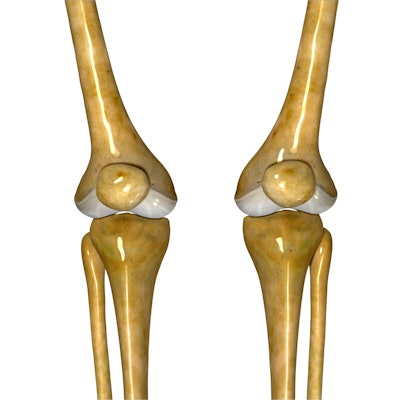
For at least one healthcare system, there is plenty of room for improvement when it comes to following the American College of Radiology's (ACR) Appropriateness Criteria for the use of MRI in nontraumatic knee pain, according to a study published online December 12 in the Journal of the American College of Radiology.
Researchers from Emory University in Atlanta found that fewer than 60% of knee MRI scans ordered by local primary care clinics were considered appropriate under ACR guidelines. Even when the exams were deemed necessary, the results seldom changed a patient's treatment regimen.
"The findings in this study support the need for tactics to improve adherence to ACR Appropriateness Criteria guidelines and reduce the overutilization of knee MRI for nontraumatic knee pain. ... We need better guidelines and tactics to reduce MRI ordering in this patient population (i.e., patients with moderate to severe osteoarthritis)," wrote lead author Dr. Felix Gonzalez and colleagues.
The ACR developed its evidence-based appropriateness guidelines for MRI for nontraumatic knee pain in 1995 and updated those standards in 2012. Despite those efforts, research has shown that the guidelines have not been widely accepted or practiced.
"Given the poor understanding of radiologic guidelines and the increased availability of advanced imaging modalities, it is not surprising that the utilization of cross-sectional imaging and its associated costs have increased over the last 15 years," the authors wrote. "This raises concerns about inappropriate utilization of cross-sectional imaging, including musculoskeletal cross-sectional imaging."
To get a handle on adherence to ACR standards, the researchers reviewed 196 consecutive MRI scans for nontraumatic knee pain ordered from primary care clinics in the Grady Health System in Atlanta between January 2014 and June 2015. Two musculoskeletal radiologists rated the appropriateness of the knee scans on a scale of 1 to 9.
Scores between 1 and 3 meant the knee MRI orders were "not usually appropriate" and "not likely to be indicated for the clinical presentation." Scores between 7 and 9 meant the MRI orders were "usually appropriate" and "indicated in the specified clinical scenario with a favorable risk-benefit ratio."
The researchers found that nearly 60% of the orders were "usually appropriate," meaning that more than 40% of the exams were "usually not appropriate." In addition, only a handful of MRI scans prompted changes in patient treatment.
| Adherence to ACR Appropriateness Criteria for knee MRI scans | ||
| Usually appropriate | Usually not appropriate | |
| Total orders | 57% | 43% |
| Change in treatment | 26% | 20% |
| No change in treatment | 74% | 80% |
So, what can be done to improve adherence to ACR Appropriateness Criteria? Gonzalez and colleagues suggested that imaging centers follow the 2018 mandate from the U.S. Centers for Medicare and Medicaid Services on the use of clinical decision-support (CDS) software with computerized physician order entry (CPOE).
"Previous studies have shown that robust CDS-CPOE software improves adherence to expert guidelines, reduces overall and inappropriate imaging utilization, and increases high-yield and decreases low-yield imaging, particularly among primary care providers," they wrote.
"Additionally, to further improve imaging effectiveness and efficiency, focus on reducing 'appropriate' studies that do not impact clinical management (e.g., cases with moderate to severe osteoarthritis) is needed," the authors concluded.



















